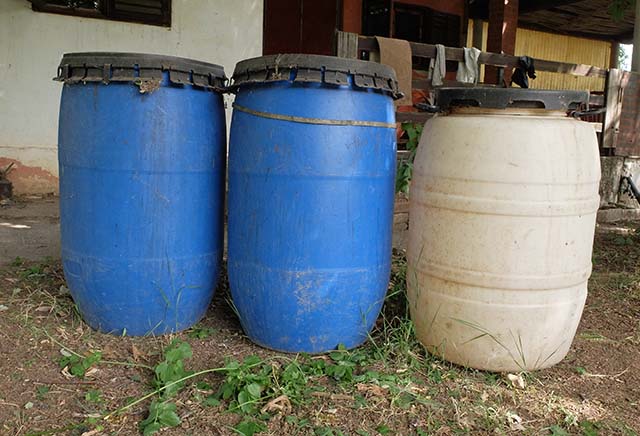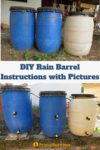I recently got an off-grid property that I use as a camp. The property has an underground rainwater storage cistern fed by the gutters.
But, because it would be costly and time-consuming to fix the system (the cistern leaks and the gutters are old), I decided to make a rainwater harvesting system using a tarp and DIY rain barrels.
Here are the step-by-step instructions on how to make your own rain barrels. The system can easily be modified to suit your needs. Mine was even made using a tarp. See this post for how to collect rainwater without a roof or gutters. You can also read all about rainwater harvesting here.
Materials
- Rain barrels with lids
- Spigot kit with bulkhead fitting (or ¾” hose adapter and ¾” spigot)
- O-rings or plumber’s tape
- Hose
- Drill with hole saw bit or spade bits
- Utility knife
- Wire screen or filter basket
Note: I used a PVC spigot and regretted it. The plastic was annoying to open/close. Invest in a good metal spigot, especially if you want to connect the rain barrel to a hose.

This DIY rain barrel kit is great and includes a downspout diverter that allows leaves to pass through as well as winterizing items. It’s a bit pricey, though. Something like this will also work.
Instructions:
1. Choose Your Rain Barrel Containers

I was lucky that there were already three large barrels on the property. They were used to make sour cabbage (the previous owner was Serbian, and they love their stuffed cabbage!), so the barrels were safe for rainwater.
You can also use pretty much any large plastic container for your rain barrels. For example, a lot of people use trash cans. However, you don’t want to use containers that contained hazardous materials. Likewise, the containers should be food safe if you want to drink the rainwater you collect.
Read:
2. Clean the Barrels
In my case, the barrels were filled with spider webs and other debris, so they needed to be cleaned out. Even if your rain barrels are new, you should rinse them to remove any plastic residue.
3. Mark Spigot Locations
It drives me crazy that so many rain barrels only have a spigot on the bottom. You should have TWO spigots: one near the bottom and another near the middle.
Here’s why.
Sediment and debris will inevitably get into the barrel and settle on the bottom. The water will always be murky if you only have a spigot on the bottom. By contrast, the water will be cleaner if you put a spigot near the middle. You only use the bottom spigot when you drain the barrels for winterizing or cleaning.
The bottom spigot should be approximately 3 inches from the base of the barrel. This allows you to drain the barrel without it getting clogged too easily.
Also read: Tips for Choosing Rain Barrels
4. Drill Spigot Holes

You’ll need to check the size of your spigot threads to know which drill bit to use. Most spigots require a ¾” hole.
Notes:
- Ensure you leave enough room between the bottom hole and the barrel’s bottom, so the spigot doesn’t hit the ground once installed.
- Some barrels have an indentation on the bottom for drilling a hole. My blue barrels did not. Because the bottom of most rain barrels is convex, the bottom spigots on my blue barrels ended up sitting at a weird angle. It doesn’t affect performance but is something to be aware of.
5. Install Spigots
There are a few ways to do this. I used the first method with an O-ring and washer. It was fairly hilarious because I had to stick my entire head into the barrel to reach the lower spigot.
- O-ring and washer inside the barrel: Screw the spigot into the hole you just drilled. Add an O-ring over the spigot threads and put a washer over the O-ring. Then screw on the bulkhead fitting.
- Put the O-ring and a washer on the outside of the barrel. Then put some caulk on the back of the washer. And then, you screw the spigot into the hole. The caulk makes it watertight.
- Use plumber’s tape. Wrap the male part of the spigot threads with the plumber’s tape. Then screw on the bulkhead fitting.
I also saw a video where someone installed rain barrel spigots by melting the hole and quickly screwing the spigot into place. The melted plastic formed a watertight seal around the spigot when it cooled.

6. Cut Hole in Lid
You need a hole for the rainwater to enter the barrel. There are two options for this. I went with option two.
Option 1: Downspout goes directly into the rain barrel.
This only makes sense, though, if you have a downspout diverter. If not, then your rain barrels will probably get clogged quickly.
Option 2: Rain enters through a mesh filter.
Another option is to cut a hole in the lid and position the downspout above it. You will need to cover the hole with a screen to keep debris and mosquitoes out. I simply cut a 6” hole and covered it with a mesh screen. I used caulk to adhere the screen in place.
You can also buy rain barrel filters, like this one by Earthminded. Just make sure that you cut the hole in the lid to fit the filter exactly. Otherwise, mosquitoes will make their way through the gaps.
7. Install Overflow Hose
An overflow hose prevents your rain barrels from overflowing when they get full. Make sure the overflow is long enough that you can aim it away from your home’s foundation – you don’t get water damage! You can also use the overflow hose to connect multiple rain barrels.
To do this, you’ll need to drill a hole the same size as your hose. It can take some wrangling to get the hose into the hole. Scrape around the edges of the hole with a utility knife or some sandpaper to slightly enlarge the hole if necessary.
Use a utility knife or fine-toothed saw to cut the hose to length. A serrated bread knife also works. I keep one of these in my toolbox.
Note: I just used some old garden hose for my overflow. If you live somewhere with very heavy rains, you’ll need a wider diameter hose. A thin hose like this won’t be able to handle all that water!
8. Connect Rain Barrels

You can daisy chain as many rain barrels in parallel as you want. A lot of systems connect the rain barrels at the bottom. I hate that system because it is prone to clogging. Instead, I prefer to connect the rain barrels near the top: when the first barrel fills, the water will spill into the next barrel in the sequence.
You need to:
- Drill an intake hole. The overflow hose from the previous barrel will go into this one.
- Drill an overflow hole on the opposite side of the intake hole.
- The last barrel should have an overflow hose leading away from your home’s foundation.
For best results, the first rain barrel should be elevated higher than the second one, the second one higher than the third one, and so forth.
Gravity will help the water flow into each successive rain barrel. This is easy to do by propping the barrels up on bricks. Just be warned that water barrels are heavy and dangerous if they topple over – so make sure the surface is stable!



Great article! I’m excited to try building my own rain barrel.